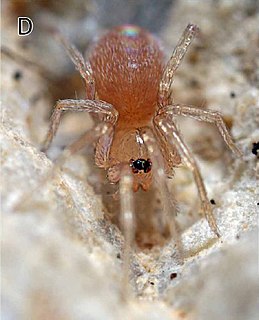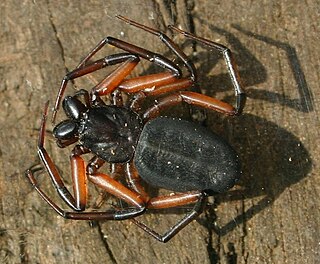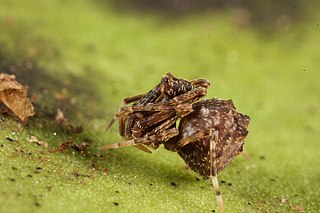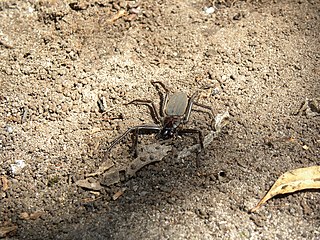
Oonopidae, also known as goblin spiders, is a family of spiders consisting of over 1,600 described species in about 113 genera worldwide, with total species diversity estimated at 2000 to 2500 species. The type genus of the family is OonopsKeyserling, 1835.

Cithaeronidae is a small family of araneomorph spiders first described by Simon in 1893 Female Cithaeron are about 5 to 7 millimetres long, males about 4 millimetres (0.16 in).

Gallieniellidae is a family of spiders first described by J. Millot in 1947. It was originally thought to be endemic to Madagascar until species were also found in southern Kenya, northeastern Argentina, and Australia. Drassodella was transferred from the family Gnaphosidae in 1990. They are suspected to be specialized in ant-preying.

Trochanteriidae is a family of spiders first described by Ferdinand Karsch in 1879 containing about 180 species in 21 genera. Most are endemic to Australia though Doliomalus and Trochanteria are from South America and Olin and Plator are from Asia. Platyoides species exist in southern and eastern Africa, Madagascar, and the Canary Islands with one species, P. walteri, introduced to Australia.

Archaeidae, also known as assassin spiders and pelican spiders, is a spider family with about ninety described species in five genera. It contains small spiders, ranging from 2 to 8 millimetres long, that prey exclusively on other spiders. They are unusual in that they have "necks", ranging from long and slender to short and fat. The name "pelican spider" refers to these elongated jaws and necks used to catch their prey. Living species of Archaeidae occur in South Africa, Madagascar and Australia, with the sister family Mecysmaucheniidae occurring in southern South America and New Zealand.

The Gnaphosoidea or gnaphosoids are a superfamily of araneomorph spiders with seven families. A 2014 study did not find the group to be monophyletic.

Platyoides is a genus of spiders belonging to the family Trochanteriidae. Its members are known as scorpion spiders and are found in sub-Saharan Africa and its islands, Madagascar, Réunion, Aldabra and the Canary Islands.

Caponiidae is a family of ecribellate haplogyne spiders that are unusual in a number of ways. They differ from other spiders in lacking book lungs and having the posterior median spinnerets anteriorly displaced to form a transverse row with the anterior lateral spinnerets. Most species have only two eyes, which is also unusual among spiders. A few species of Caponiidae variously have four, six or eight eyes. In some species the number of eyes will increase when the spiderling changes its skin as it grows towards adulthood.
Barrowammo is a genus of North and West Australian termite hunters containing the single species, Barrowammo waldockae. It was first described by Norman I. Platnick in 2002, and has only been found in Australia. The name is a portmanteau of Barrow Island and Ammoxenidae.
Boolathana is a genus of spiders in the family Trochanteriidae found in western Australia. There are two species in the genus, Boolathana mainae and Boolathana spiralis. It is named after Boolathana Station, a pastoral lease near where the first specimen was found.
Boolathana spiralis is one of two species of western Australian spiders in the family Trochanteriidae. The name refers to the coiled tip of the middle apophysis, one of the defining characteristics of the species. It is mostly red to brown, the color fading from dark on the top front to gray in the sides and bottom.
Austrammo is a genus of Australian termite hunters first described by Norman I. Platnick in 2002.
Drassodella is a genus of African araneomorph spiders in the family Gallieniellidae, and was first described by John Hewitt in 1916. Originally placed with the ground spiders, it was moved to the Gallieniellidae in 1990.
Gallieniella is a genus of East African araneomorph spiders in the family Gallieniellidae, and was first described by J. Millot in 1947. Originally placed with the sac spiders, it was moved to the Gallieniellidae in 1967.
Peeto is a monotypic genus of Australian araneomorph spiders in the family Gallieniellidae containing the single species, Peeto rodmani. It was first described by Norman I. Platnick in 2002, and has only been found in Australia.
Questo is a monotypic genus of Australian araneomorph spiders in the family Gallieniellidae containing the single species, Questo annuello, named after where it was found, Annuello, Victoria. It was first described by Norman I. Platnick in 2002, and has only been found in Australia.

Morebilus is a genus of spiders in the family Trochanteriidae found in southern and western Australia, first described by Norman I. Platnick in 2002. These are large spiders, with the carapace of males ranging from 10 to 16 millimeters and those of females ranging from 10 to 24 millimeters. They look similar to members of Rebilus, especially the spinneret and tarsal claw, but members of this genus have an inclined lip at the anterior edge of the sternum as well as a pair of enlarged sclerites on the coxal glands.
Neato is a genus of Australian araneomorph spiders in the family Gallieniellidae, and was first described by Norman I. Platnick in 2002.
Meedo is a genus of Australian araneomorph spiders in the family Gallieniellidae, and was first described by Barbara York Main in 1987.







